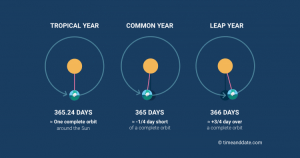This year February has 29 days rather than 28. It’s what is known as a leap year. Do you know why leap years exist? Because it takes the Earth 365.24 days to orbit the sun. That time adds up! So to keep the calendar right we have leap years!
Leap years are years where an extra, or intercalary, day is added to the end of the shortest month, February. The intercalary day, February 29, is commonly referred to as leap day. Leap years have 366 days instead of the usual 365 days and occur almost every four years.
Leap years in the western calendar were first introduced over 2000 years ago by Roman general Julius Caesar. The Julian calendar, which was named after him, had only one rule: any year evenly divisible by four would be a leap year. This formula produced too many leap years, causing the Julian calendar to drift apart from the tropical year at a rate of 1 day per 128 years. This was not corrected until the introduction of the Gregorian calendar more than 1500 years later, when a number of days were skipped to realign our calendar with the seasons.

There is an official Leap Day cocktail and it’s called…the Leap Day Cocktail! This colorful cousin of the martini was invented by pioneering bartender Harry Craddock at London’s Savoy Hotel in 1928. According to the 1930 Savoy Cocktail Book, “It is said to have been responsible for more proposals than any other cocktail ever mixed”. Whether or not you’re in the market for a freshly soused spouse, you can make your own Leap Day cocktail with Craddock’s original recipe:
1 dash lemon juice
2/3 gin
1/6 Grand Marnier
1/6 sweet vermouth
Shake, serve, garnish with a lemon peel, and enjoy the flood of bittersweet flavors. It’s like a marriage, in your mouth!